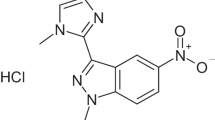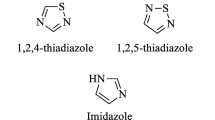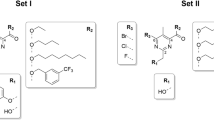Abstract
Aim:
To evaluate the efficacies of six derivatives of Compound 2, a novel YycG histidine kinase inhibitor with the thiazolidione core structure in the treatment of medical device-related biofilm infections.
Methods:
The minimal inhibitory concentration (MIC) of the derivatives was determined using the macrodilution broth method, and the minimal bactericidal concentration (MBC) was obtained via sub-culturing 100 μL from each negative tube from the MIC assay onto drug-free Mueller-Hinton agar plates. Biofilm-killing effect for immature (6 h-old) biofilms was examined using a semiquantitative plate assay, and the effect on mature (24 h-old) biofilms was observed under a confocal laser scanning microscope (CLSM).
Results:
The derivatives potently suppressed the growth of Staphylococcus epidermidis. The MIC values of the derivatives H2-10, H2-12, H2-20, H2-29, H2-27, and H2-28 on S epidermidis ATCC 35984 were 24.3, 6.5, 6.2, 3.3, 3.1, and 1.5 μg/mL, respectively. The MBC values of these derivatives were 48.6, 52.2, 12.4, 52.6, 12.4, and 6.2 μg/mL, respectively. The derivatives killed all bacteria in immature (6 h-old) biofilms and eliminated the biofilm proliferation. The derivatives also displayed strong bactericidal activities toward cells in mature (24 h-old) biofilms, whereas they showed low cytotoxicity and hemolytic activity toward Vero cells and human erythrocytes.
Conclusion:
The bactericidal and biofilm-killing activities of the new anti-YycG compounds were significantly better than the parent Compound 2.
Similar content being viewed by others
Log in or create a free account to read this content
Gain free access to this article, as well as selected content from this journal and more on nature.com
or
References
Rupp ME, Archer GL . Coagulase-negative staphylococci: pathogens associated with medical progress. Clin Infect Dis 1994; 19: 231–43; quiz 44–5.
Huebner J, Goldmann DA . Coagulase-negative staphylococci: role as pathogens. Annu Rev Med 1999; 50: 223–36.
Mermel LA, Farr BM, Sherertz RJ, Raad II, O'Grady N, Harris JS, et al. Guidelines for the management of intravascular catheter-related infections. Infect Control Hosp Epidemiol 2001; 22: 222–42.
Donlan RM, Costerton JW . Biofilms: survival mechanisms of clinically relevant microorganisms. Clin Microbiol Rev 2002; 15: 167–93.
Vandecasteele SJ, Peetermans WE, Merckx R, Van Eldere J . Expression of biofilm-associated genes in Staphylococcus epidermidis during in vitro and in vivo foreign body infections. J Infect Dis 2003; 188: 730–7.
Hoffman LR, D'Argenio DA, MacCoss MJ, Zhang Z, Jones RA, Miller SI . Aminoglycoside antibiotics induce bacterial biofilm formation. Nature 2005; 436: 1171–5.
Raad I, Alrahwan A, Rolston K . Staphylococcus epidermidis: emerging resistance and need for alternative agents. Clin Infect Dis 1998; 26: 1182–7.
Zhang YQ, Ren SX, Li HL, Wang YX, Fu G, Yang J, et al. Genome-based analysis of virulence genes in a non-biofilm-forming Staphylococcus epidermidis strain (ATCC 12228). Mol Microbiol 2003; 49: 1577–93.
Gill SR, Fouts DE, Archer GL, Mongodin EF, Deboy RT, Ravel J, et al. Insights on evolution of virulence and resistance from the complete genome analysis of an early methicillin-resistant Staphylococcus aureus strain and a biofilm-producing methicillin-resistant Staphylococcus epidermidis strain. J Bacteriol 2005; 187: 2426–38.
Stock AM, Wylie DC, Mottonen JM, Lupas AN, Ninfa EG, Ninfa AJ, et al. Phosphoproteins involved in bacterial signal transduction. Cold Spring Harb Symp Quant Biol 1988; 53: 49–57.
Stock AM, Robinson VL, Goudreau PN . Two-component signal transduction. Annu Rev Biochem 2000; 69: 183–215.
West AH, Stock AM . Histidine kinases and response regulator proteins in two-component signaling systems. Trends Biochem Sci 2001; 26: 369–76.
Barrett JF, Hoch JA . Two-component signal transduction as a target for microbial anti-infective therapy. Antimicrob Agents Chemother 1998; 42: 1529–36.
Stephenson K, Hoch JA . Two-component and phosphorelay signal-transduction systems as therapeutic targets. Curr Opin Pharmacol 2002; 2: 507–12.
Stephenson K, Hoch JA . Virulence- and antibiotic resistance-associated two-component signal transduction systems of Gram-positive pathogenic bacteria as targets for antimicrobial therapy. Pharmacol Ther 2002; 93: 293–305.
Fabret C, Hoch JA . A two-component signal transduction system essential for growth of Bacillus subtilis: implications for anti-infective therapy. J Bacteriol 1998; 180: 6375–83.
Fukuchi K, Kasahara Y, Asai K, Kobayashi K, Moriya S, Ogasawara N . The essential two-component regulatory system encoded by yycF and yycG modulates expression of the ftsAZ operon in Bacillus subtilis. Microbiology 2000; 146: 1573–83.
Martin PK, Li T, Sun D, Biek DP, Schmid MB . Role in cell permeability of an essential two-component system in Staphylococcus aureus. J Bacteriol 1999; 181: 3666–73.
Dubrac S, Boneca IG, Poupel O, Msadek T . New insights into the WalK/WalR (YycG/YycF) essential signal transduction pathway reveal a major role in controlling cell wall metabolism and biofilm formation in Staphylococcus aureus. J Bacteriol 2007; 189: 8257–69.
Dubrac S, Msadek T . Tearing down the wall: peptidoglycan metabolism and the WalK/WalR (YycG/YycF) essential two-component system. Adv Exp Med Biol 2008; 631: 214–28.
Okada A, Igarashi M, Okajima T, Kinoshita N, Umekita M, Sawa R, et al. Walkmycin B targets WalK (YycG), a histidine kinase essential for bacterial cell growth. J Antibiot (Tokyo) 2010; 63: 89–94.
Watanabe T, Hashimoto Y, Yamamoto K, Hirao K, Ishihama A, Hino M, et al. Isolation and characterization of inhibitors of the essential histidine kinase, YycG in Bacillus subtilis and Staphylococcus aureus. J Antibiot (Tokyo) 2003; 56: 1045–52.
Yamamoto K, Kitayama T, Minagawa S, Watanabe T, Sawada S, Okamoto T, et al. Antibacterial agents that inhibit histidine protein kinase YycG of Bacillus subtilis. Biosci Biotechnol Biochem 2001; 65: 2306–10.
Qin Z, Zhang J, Xu B, Chen L, Wu Y, Yang X, et al. Structure-based discovery of inhibitors of the YycG histidine kinase: new chemical leads to combat Staphylococcus epidermidis infections. BMC Microbiol 2006; 6: 96.
Qin Z, Lee B, Yang L, Zhang J, Yang X, Qu D, et al. Antimicrobial activities of YycG histidine kinase inhibitors against Staphylococcus epidermidis biofilms. FEMS Microbiol Lett 2007; 273: 149–56.
Pan B, Huang RZ, Han SQ, Qu D, Zhu ML, Wei P, et al. Design, synthesis, and antibiofilm activity of 2-arylimino-3-aryl-thiazolidine-4-ones. Bioorg Med Chem Lett 2010; 20: 2461–4.
Clinical and Laboratory Standards Institute: Methods for dilution antimicrobial susceptibility tests for bacteria that grow aerobically, 7th ed. In Approved standard M7-A7 Clinical and Laboratory Standards Institute, Villanova, PA, USA; 2006.
Christensen GD, Simpson WA, Younger JJ, Baddour LM, Barrett FF, Melton DM, et al. Adherence of coagulase-negative staphylococci to plastic tissue culture plates: a quantitative model for the adherence of staphylococci to medical devices. J Clin Microbiol 1985; 22: 996–1006.
Mack D, Davies AP, Harris LG, Rohde H, Horstkotte MA, Knobloch JK . Microbial interactions in Staphylococcus epidermidis biofilms. Anal Bioanal Chem 2007; 387: 399–408.
Evans RC, Holmes CJ . Effect of vancomycin hydrochloride on Staphylococcus epidermidis biofilm associated with silicone elastomer. Antimicrob Agents Chemother 1987; 31: 889–94.
Baddour LM, Bettmann MA, Bolger AF, Epstein AE, Ferrieri P, Gerber MA, et al. Nonvalvular cardiovascular device-related infections. Clin Infect Dis 2004; 38: 1128–30.
Ceri H, Olson ME, Stremick C, Read RR, Morck D, Buret A . The Calgary Biofilm Device: new technology for rapid determination of antibiotic susceptibilities of bacterial biofilms. J Clin Microbiol 1999; 37: 1771–6.
Presterl E, Suchomel M, Eder M, Reichmann S, Lassnigg A, Graninger W, et al. Effects of alcohols, povidone-iodine and hydrogen peroxide on biofilms of Staphylococcus epidermidis. J Antimicrob Chemother 2007; 60: 417–20.
Mulcahy H, Charron-Mazenod L, Lewenza S . Extracellular DNA chelates cations and induces antibiotic resistance in Pseudomonas aeruginosa biofilms. PLoS Pathog 2008; 4: e1000213.
Gao R, Stock AM . Biological insights from structures of two-component proteins. Annu Rev Microbiol 2009; 63: 133–54.
Wagner C, Saizieu Ad A, Schonfeld HJ, Kamber M, Lange R, Thompson CJ, et al. Genetic analysis and functional characterization of the Streptococcus pneumoniae vic operon. Infect Immun 2002; 70: 6121–8.
Bisicchia P, Noone D, Lioliou E, Howell A, Quigley S, Jensen T, et al. The essential YycFG two-component system controls cell wall metabolism in Bacillus subtilis. Mol Microbiol 2007; 65: 180–200.
Dubrac S, Msadek T . Identification of genes controlled by the essential YycG/YycF two-component system of Staphylococcus aureus. J Bacteriol 2004; 186: 1175–81.
Howell A, Dubrac S, Andersen KK, Noone D, Fert J, Msadek T, et al. Genes controlled by the essential YycG/YycF two-component system of Bacillus subtilis revealed through a novel hybrid regulator approach. Mol Microbiol 2003; 49: 1639–55.
Liu M, Hanks TS, Zhang J, McClure MJ, Siemsen DW, Elser JL, et al. Defects in ex vivo and in vivo growth and sensitivity to osmotic stress of group A Streptococcus caused by interruption of response regulator gene vicR. Microbiology 2006; 152: 967–78.
Ng WL, Robertson GT, Kazmierczak KM, Zhao J, Gilmour R, Winkler ME . Constitutive expression of PcsB suppresses the requirement for the essential VicR (YycF) response regulator in Streptococcus pneumoniae R6. Mol Microbiol 2003; 50: 1647–63.
Ng WL, Tsui HC, Winkler ME . Regulation of the pspA virulence factor and essential pcsB murein biosynthetic genes by the phosphorylated VicR (YycF) response regulator in Streptococcus pneumoniae. J Bacteriol 2005; 187: 7444–59.
Mohedano ML, Overweg K, de la Fuente A, Reuter M, Altabe S, Mulholland F, et al. Evidence that the essential response regulator YycF in Streptococcus pneumoniae modulates expression of fatty acid biosynthesis genes and alters membrane composition. J Bacteriol 2005; 187: 2357–67.
Ahn SJ, Wen ZT, Burne RA . Effects of oxygen on virulence traits of Streptococcus mutans. J Bacteriol 2007; 189: 8519–27.
Kadioglu A, Echenique J, Manco S, Trombe MC, Andrew PW . The MicAB two-component signaling system is involved in virulence of Streptococcus pneumoniae. Infect Immun 2003; 71: 6676–9.
Senadheera MD, Guggenheim B, Spatafora GA, Huang YC, Choi J, Hung DC, et al. A VicRK signal transduction system in Streptococcus mutans affects gtfBCD, gbpB, and ftf expression, biofilm formation, and genetic competence development. J Bacteriol 2005; 187: 4064–76.
Ahn SJ, Burne RA . Effects of oxygen on biofilm formation and the AtlA autolysin of Streptococcus mutans. J Bacteriol 2007; 189: 6293–302.
Shemesh M, Tam A, Feldman M, Steinberg D . Differential expression profiles of Streptococcus mutans ftf, gtf and vicR genes in the presence of dietary carbohydrates at early and late exponential growth phases. Carbohydr Res 2006; 341: 2090–7.
Gilmour R, Foster JE, Sheng Q, McClain JR, Riley A, Sun PM, et al. New class of competitive inhibitor of bacterial histidine kinases. J Bacteriol 2005; 187: 8196–200.
Kitayama T, Iwabuchi R, Minagawa S, Sawada S, Okumura R, Hoshino K, et al. Synthesis of a novel inhibitor against MRSA and VRE: preparation from zerumbone ring opening material showing histidine-kinase inhibition. Bioorg Med Chem Lett 2007; 17: 1098–101.
Okada A, Gotoh Y, Watanabe T, Furuta E, Yamamoto K, Utsumi R . Targeting two-component signal transduction: a novel drug discovery system. Methods Enzymol 2007; 422: 386–95.
Stephenson K, Hoch JA . Developing inhibitors to selectively target two-component and phosphorelay signal transduction systems of pathogenic microorganisms. Curr Med Chem 2004; 11: 765–73.
Khardori N, Yassien M, Wilson K . Tolerance of Staphylococcus epidermidis grown from indwelling vascular catheters to antimicrobial agents. J Ind Microbiol 1995; 15: 148–51.
Acknowledgements
We would like to thank Prof Guo-qiang LIN, Shanghai Institute of Organic Chemistry, Chinese Academy of Sciences, for his invaluable advice. This work was supported by the Program of Ministry of Science and Technology of China (2012ZX09301002-005, 2012ZX10003008-010, and 2010DFA32100), the National Natural Science Foundation of China (30800036, 20942006, 21072095, and 81101214), the Scientific Technology Development Foundation of Shanghai (08JC1401600 and 10410700600), the High-Tech Research and Development Program of China (2006AA02A253), and the Specialized Research Fund for the Doctoral Program of Higher Education (SRFDP) (20100071120049).
Author information
Authors and Affiliations
Corresponding authors
Rights and permissions
About this article
Cite this article
Huang, Rz., Zheng, Lk., Liu, Hy. et al. Thiazolidione derivatives targeting the histidine kinase YycG are effective against both planktonic and biofilm-associated Staphylococcus epidermidis. Acta Pharmacol Sin 33, 418–425 (2012). https://doi.org/10.1038/aps.2011.166
Received:
Accepted:
Published:
Issue date:
DOI: https://doi.org/10.1038/aps.2011.166
Keywords
This article is cited by
-
Antibacterial and anti-biofilm activities of thiazolidione derivatives against clinical staphylococcus strains
Emerging Microbes & Infections (2015)
-
Efficacy of novel antibacterial compounds targeting histidine kinase YycG protein
Applied Microbiology and Biotechnology (2014)



